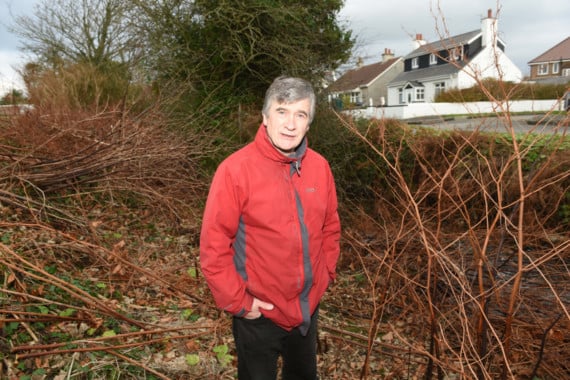Environment Minister Geoffrey Boot has admitted his department struggles to control the invasive plant Japanese knotweed.
The Department of Environment, Food and Agriculture recently awarded a grant to the Friends of the Neb voluntary group, which has in its remit to tackle Japanese knotweed and Himalayan balsam in the River Neb catchment.
In the House of Keys on Tuesday Rob Callister (Onchan) asked Mr Boot what his department was doing to ensure private landowners, contractors and local authorities were removing Japanese knotweed correctly.
Mr Boot said: ’Within the DEFA estate we are under-resourced and find it difficult to control Japanese knotweed.
’There have to be priorities and that is why we welcome the formation of a voluntary body, which we hope will grow in the same way as Beach Buddies.’
He said that it was an offence to grow Japanese knotweed or knowingly allow it to grow.
’From a farming perspective - and bearing in mind the farming community manages 80% of our island agricultural and open land - this is an aspect that we are considering at the moment as part of the reform of agricultural support,’ he added.
’There could be cross-compliance conditions imposed in terms of controlling Japanese knotweed.’
Mr Boot said Japanese knotweed caused ’land management challenges’ throughout the British Isles.
DEFA uses chemical treatment on knotweed it finds on its own land. When it is found on private land, the landowner is advised and it is their responsibility to remove it and dispose of it ’responsibly’.
Although once it is established it is difficult to control and its roots can cause extensive damage, it Japanese knotweed is not known to be harmful to humans.
MLC Bill Henderson later said; ’The spread of this invasive and alien plant species has been well known to the island for years and the natural habitat loss it is causing by its fast growth and quick spread. You just need to look at the lower parts of Glen Maye and indeed in the East Baldwin valley near the old school house to realise just how destructive it is to our environment.’
He added: ’This plant is not only a menace to our natural Manx environment but to land and property owners as well because of its fast growth and spread. It can even grow through concrete. There by posing a threat to farming, property and development.’
There have been initiatives to rid areas of the plant.
Arbory Commissioners have concentrated on the banks of the Colby River.
Meanwhile, the Friends of the Neb aim to eradicate Himalayan balsam and Japanese knotweed from the catchment area of the river that flows into Peel in the next five to 10 years.
The group has set up a Facebook page, which is intended to become a forum where members of our community can become better informed, contribute to this scheme by reporting sightings.
Japanese knotweed can undermine property.
Both it and Himalayan balsam are highly invasive and damage watercourse banks, leading to erosion and increased silt, which is detrimental to fish spawning and harbours such as Peel’s.
They also out compete native plants by being more vigorous and shading them out.
The Friends of the Neb intend to be able to identify and map where these plants are growing.
Japanese knotweed (scientific name Fallopia japonica) also known as donkey’s rhubarb, was introduced to Britain from the Far East in 1825 as an ornamental plant.
It is the most invasive plant in Britain. It spreads rapidly, especially on waste ground and next to streams and rivers, forming uniform stands that shade out native plants thereby damaging wildlife habitats. It can also be seen in gardens and on derelict areas and can pose a problem to property developers due to structural damage to buildings caused by its roots and stems.
The main problem is that it spreads so easily through fragments of the roots (rhizomes) in contaminated topsoil or by stem cuttings in garden waste.
Knotweed can grow in almost any habitat, and once established, it is very difficult to control.
For this reason the Wildlife Act 1990 makes it an offence to plant Japanese knotweed ’or otherwise cause it to grow in the wild’.
What does it look like?
In spring, red shoots appear with rolled up reddish purple leaves. The plant grows rapidly, up to 10cm a day, and the leaves unfurl, becoming lime green and later darkening to mid green colour. The stems elongate and look similar to bamboo, as they are hollow with prominent nodes. However Knotweed stems tend to zigzag and possess reddish-purple speckles. Each leaf is carried on a short stem at a different level from the next leaf below or above. Sometimes the young leaf has a subtle stripe. In summer the mature plant reaches up to 3m in height. Clusters of creamy white flowers are produced in late summer/early autumn. No viable seeds have been found in the British Isles.
In winter the plant dies back leaving woody stems that turn dark brown. These can persist for 3 years and prevent the growth of native plants by covering the ground with dense litter.
Indentifying whether there is rhizome or crown fragments in the soil can be difficult. Look out for the carrot-like orange red core of the rhizome and the hard brown crown from which the shoots grow.
How does Japanese knotweed spread?
Japanese knotweed has extensive, deep roots called rhizomes. These can be up to 3m (10 feet) deep and can extend out to 7m (23 feet) from the parent plant. Think of the plant as an iceberg, with a third of the plant above ground and two thirds under ground in the form of rhizomes, with an ability to spread.
Knotweed does not normally spread by seeds. However it can grow from cut stems, crowns or rhizomes:
Rhizome fragments of 1cm (0.7g) can sprout a new plant
Stem cuttings from mowing, flailing, or strimming can re-grow and establish new plants
Crowns can withstand drying and composting to sprout new red buds and create new plants
The stem has a characteristic red speckled pattern.
Shoots appear from nodes on the stem.
The crown is at the base of the stem and is highly resistant to drying so it is capable of surviving composting and can regenerate into new plants.
This plant easily spreads to other areas if cut stems, shoots, crowns or roots (rhizomes) are distributed.
DO
Check your land for the presence of knotweed, especially along watercourses.
Pull stems in June and July and lay them on an impermeable surface until they are dry and brown and can be burnt.
Treat with herbicide in accordance with the instructions on the pack and guidance here.
DON’T
Tip green waste on verges, riversides, cliffs or derelict ground.
Cut and spread knotweed cuttings or chippings from affected areas.
Move or spread topsoil from Japanese knotweed contaminated sites.
Move any parts of the plant (including dead-looking or uprooted stems) any more than is absolutely necessary - it is incredibly easy to spread this plant.



.jpg?width=209&height=140&crop=209:145,smart&quality=75)
.jpeg?width=209&height=140&crop=209:145,smart&quality=75)
Comments
This article has no comments yet. Be the first to leave a comment.